Did you know that over 377 years of Spanish colonial rule left an indelible mark on the Philippines? This influence is most evident in the country’s rich culinary traditions. The blending of indigenous ingredients with Spanish techniques created a unique food culture that continues to thrive today.
Spanish settlers introduced ingredients like tomatoes, garlic, and olive oil, which became staples in local dishes. They also brought cooking methods such as stewing and frying, which transformed traditional recipes. This fusion of flavors and techniques gave birth to iconic dishes that are now celebrated across the archipelago.
Beyond ingredients, Spanish influence shaped the way meals are prepared and enjoyed. Festive dishes like lechon and paella highlight the cultural significance of food during celebrations. These traditions reflect a deep connection between history, religion, and daily life.
This article explores how Spanish colonialism, alongside other cultural influences, shaped the evolution of local culinary practices. From the streets of Cebu to the bustling markets of Manila, the story of these flavors is as diverse as the islands themselves.
Key Takeaways
- Spanish colonial rule lasted 377 years, deeply influencing local food traditions.
- Ingredients like tomatoes and garlic were introduced by Spanish settlers.
- Cooking methods such as stewing and frying became integral to local recipes.
- Festive dishes like lechon and paella reflect cultural and religious celebrations.
- The fusion of indigenous and Spanish elements created a unique culinary identity.
Introduction: The Culinary Journey of Filipino Cuisine Under Spanish Influence
From ancient trade routes to colonial influences, the evolution of food reflects a rich history. The islands’ unique geography and maritime connections played a significant role in shaping its culinary identity. Over centuries, foreign elements merged with indigenous practices, creating a diverse and flavorful tradition.
Historical trade routes brought new ingredients and techniques to the archipelago. Spanish colonization introduced staples like tomatoes, garlic, and olive oil. These additions transformed local recipes, blending traditional methods with innovative approaches.
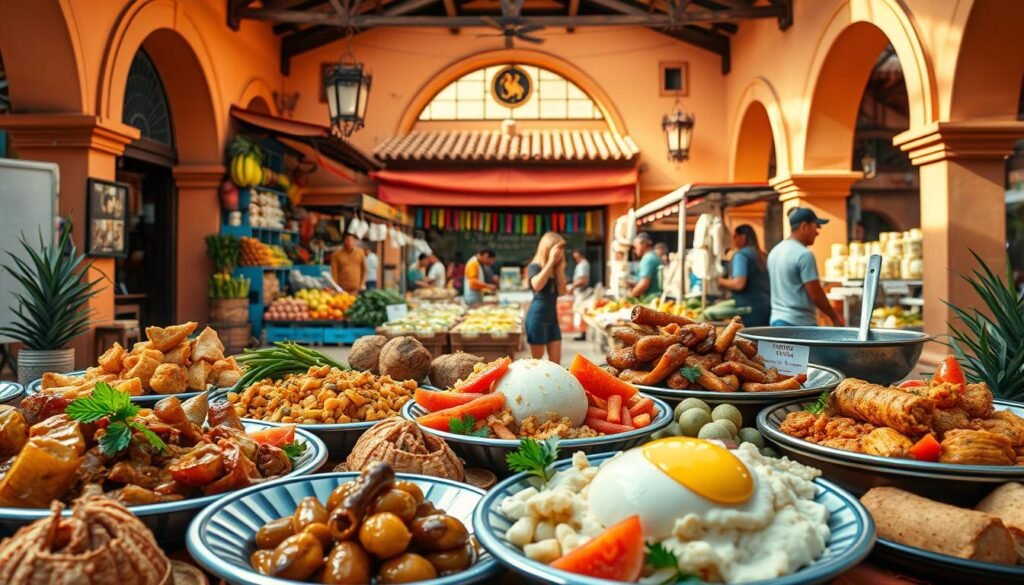
The fusion of cultures set the stage for a culinary transformation. Indigenous practices adapted to foreign influences, resulting in dishes that are both familiar and unique. This blend of flavors and techniques continues to define the region’s food culture today.
Geography also played a crucial role in this journey. The islands’ diverse landscapes allowed for a wide variety of ingredients to thrive. From coastal seafood to mountain-grown produce, each region contributed to the rich tapestry of flavors.
As we explore the historical roots and lasting influence of these culinary exchanges, we uncover the story behind the food. This journey reveals how the past has shaped the present, creating a legacy that continues to evolve.
Historical Roots of Filipino Cuisine
Long before foreign influences, the roots of local food traditions were deeply embedded in the land. The early inhabitants relied on the natural bounty of the archipelago, creating a food culture that was both practical and deeply tied to their environment. This foundation laid the groundwork for the rich culinary heritage we see today.
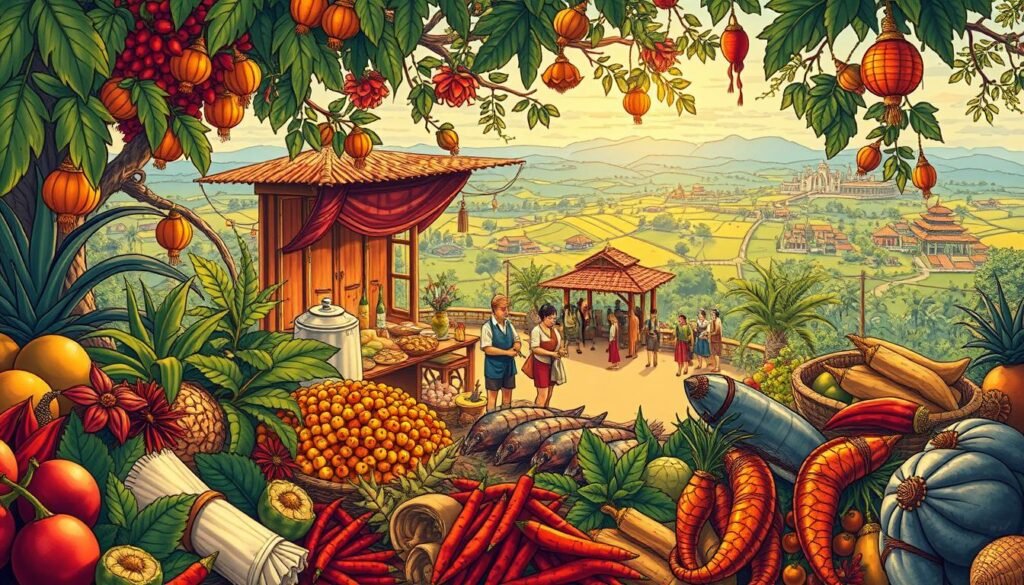
Understanding Early Food Traditions
Early food practices were shaped by the availability of local ingredients. Rice, fish, and root crops were staples, reflecting the agricultural and maritime lifestyle of the people. Cooking methods like boiling, grilling, and fermenting were common, preserving food in a tropical climate.
Communal cooking and dining were central to these traditions. Meals were often prepared and shared during gatherings, strengthening social bonds. This communal spirit remains a cornerstone of food culture, even in modern times.
A Glimpse at Indigenous Practices
Indigenous practices emphasized sustainability and resourcefulness. For example, the use of banana leaves as natural wrappers for cooking and serving food showcased ingenuity. These methods were passed down through generations, preserving the essence of early traditions.
Local ingredients like coconut, taro, and wild herbs were integral to daily meals. These elements not only provided nourishment but also reflected a deep connection to the land. The fusion of simplicity and flavor in these practices continues to inspire modern dishes.
By understanding these early foundations, we gain insight into how tradition and culture have shaped the evolution of food. These practices remind us of the resilience and creativity of the people who laid the groundwork for a vibrant culinary identity.
Pre-Colonial Foundations and Indigenous Ingredients
The culinary heritage of the Philippines has deep roots in its pre-colonial past. Long before foreign influences, the archipelago’s food traditions were shaped by the natural bounty of the land and the ingenuity of its people. Indigenous practices laid the groundwork for a vibrant culinary identity that continues to thrive today.

The Austronesian Legacy in Food
The migration of Austronesian peoples brought agricultural practices that formed the foundation of local food culture. These early settlers introduced rice cultivation, which became a staple in the diet. The techniques they used, such as swidden agriculture, allowed communities to sustainably grow crops like rice, millet, and root vegetables.
Rice, in particular, held immense significance. It was not just a source of nourishment but also a symbol of community and prosperity. Pre-colonial societies developed intricate methods for its cultivation, ensuring its role as a central element in daily meals and cultural rituals.
Indigenous Ingredients and Preparation
The variety of native ingredients available in the archipelago greatly influenced local food preparation. Coconut, taro, and wild herbs were commonly used, showcasing the resourcefulness of early inhabitants. Cooking methods like boiling, grilling, and fermenting preserved these ingredients in a tropical climate.
Communal practices also played a vital role. Meals were often prepared and shared during gatherings, strengthening social bonds. This sense of community remains a cornerstone of the region’s food traditions, reflecting the enduring influence of pre-colonial customs.
Resilience of Indigenous Foodways
Despite centuries of foreign influence, indigenous foodways have remained resilient. Techniques like using banana leaves as natural wrappers and fermenting ingredients for preservation are still practiced today. These methods highlight the creativity and adaptability of early societies.
The legacy of pre-colonial food traditions is evident in modern dishes, where simplicity and flavor continue to inspire. By understanding these foundations, we gain a deeper appreciation for the rich culinary heritage that defines the region.
Spanish Colonial Period: Transformation of Flavors
The Spanish colonial era brought a wave of culinary transformation to the islands. Over centuries of rule, new ingredients and techniques reshaped local food traditions. This period marked the beginning of a unique fusion that continues to define the region’s culinary identity.
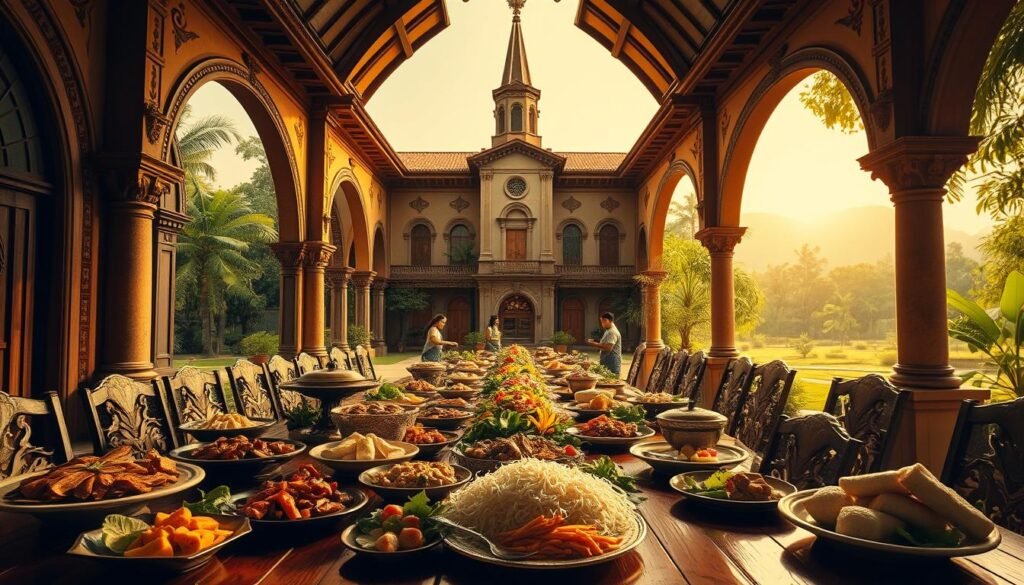
Introduction of New Spices and Cooking Methods
Spanish settlers introduced ingredients like vinegar, which became a staple in local cooking. They also brought techniques such as stewing and marinating, which transformed traditional recipes. These methods allowed for the creation of iconic dishes like adobo, a savory blend of meat, vinegar, and spices.
The use of vinegar not only added flavor but also served as a natural preservative. This was especially useful in the tropical climate, where food spoilage was a concern. The stewing process, slow and deliberate, allowed flavors to meld beautifully, creating rich and hearty meals.
The Impact of the Manila Galleon Trade
The Manila Galleon Trade played a pivotal role in this culinary evolution. This trade route connected the islands to global markets, bringing in spices, herbs, and cooking techniques from Spain and beyond. Ingredients like tomatoes, garlic, and olive oil became integral to local dishes.
This exchange also introduced new cooking methods, such as sofrito, a base of sautéed onions, garlic, and tomatoes. These additions enriched local recipes, blending indigenous practices with foreign influences. The result was a vibrant culinary tradition that continues to thrive today.
To learn more about the broader impact of Spanish colonization, visit this detailed analysis.
Chinese and Mexican Culinary Contributions
The culinary landscape of the Philippines was shaped not only by Spanish influence but also by contributions from Chinese and Mexican traditions. These external influences blended seamlessly with local practices, creating a unique and diverse food culture.
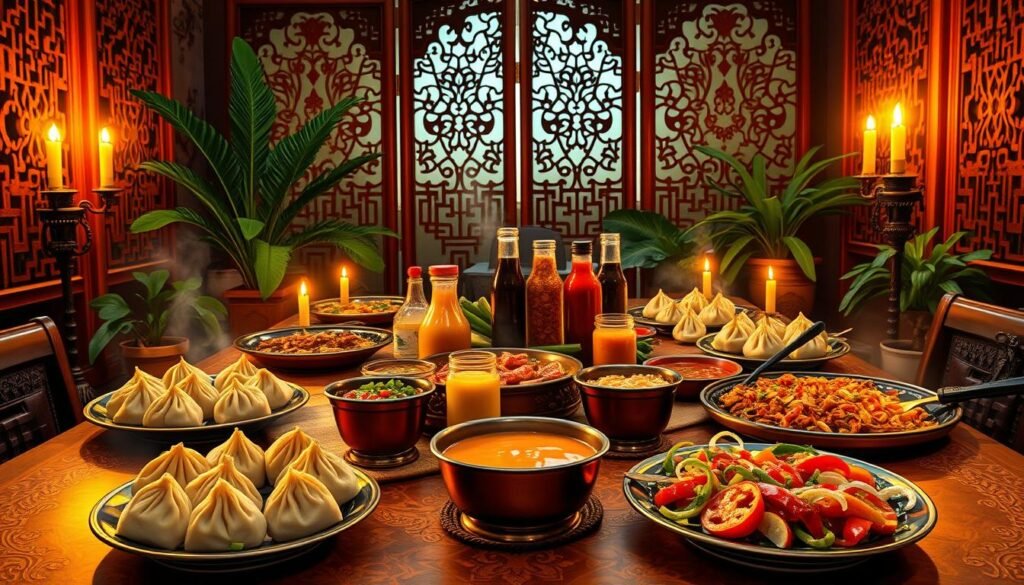
Adoption of Noodles and Soy Sauce
Chinese traders played a significant role in introducing noodles and soy-based condiments to the islands. Dishes like pancit, a staple in local meals, showcase this influence. The term “pancit” comes from the Hokkien word “piān-ê-si̍t,” meaning “conveniently cooked.”
Noodle dishes, such as pancit Malabon and pancit Lucban, highlight regional variations. These recipes often incorporate local ingredients, blending Chinese techniques with indigenous flavors. Soy sauce, another key contribution, became a fundamental seasoning in many dishes.
Mexican Influences in Ingredients and Techniques
The Manila Galleon Trade brought Mexican ingredients and cooking methods to the Philippines. Ingredients like tomatoes, corn, and chili peppers were introduced, enriching local recipes. Techniques such as marinating and stewing were also adopted, adding depth to traditional dishes.
One notable example is the use of chicharrón, fried pork rinds, which became a popular snack. This reflects the cultural exchange between Mexico and the Philippines. The fusion of these elements created a vibrant culinary tradition that continues to evolve.
Together, Chinese and Mexican contributions have left a lasting legacy, shaping the region’s food culture into what it is today.
Filipino Cuisine
The rich tapestry of dishes in the Philippines reflects centuries of cultural exchange. From hearty stews to vibrant street food, the variety is astounding. Each dish tells a story of adaptation, blending indigenous ingredients with foreign influences.
Traditional recipes have evolved over time, incorporating techniques and flavors from Spain, China, and Mexico. For example, adobo, a savory stew, now includes soy sauce—a Chinese contribution. This adaptability highlights the creativity behind local recipes.
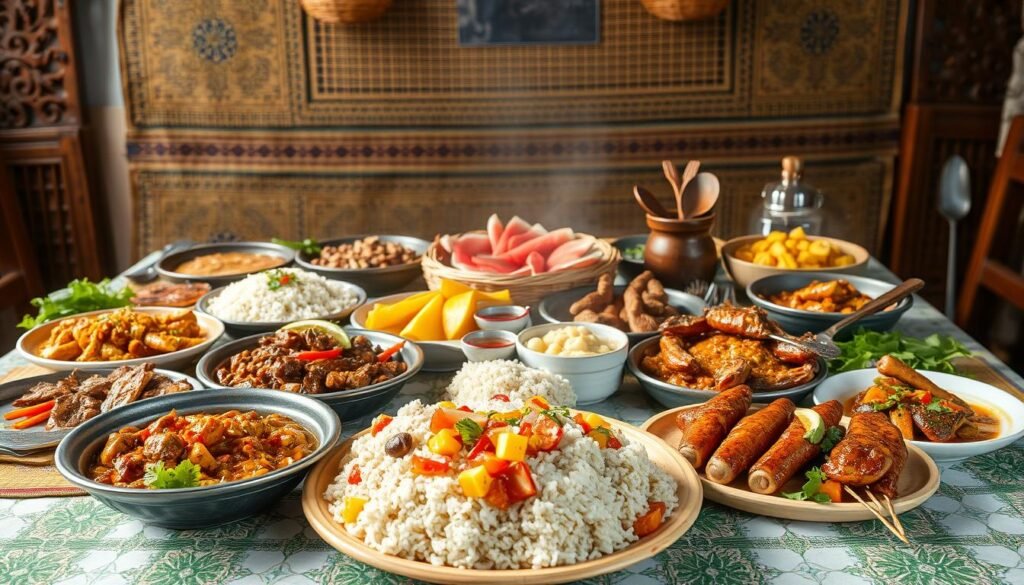
What sets these dishes apart is their uniqueness. Recipes are often passed down through generations, with each family adding their own twist. Regional variations also play a role, as ingredients and tastes differ across the archipelago.
“Food is not just nourishment; it’s a way to connect with our heritage and each other.”
The dynamic nature of cooking ensures that traditional methods are honored while embracing modern trends. Whether it’s a festive dish like lechon or a simple bowl of sinigang, the essence of the culture shines through.
| Dish | Key Ingredients | Cultural Influence |
|---|---|---|
| Adobo | Vinegar, soy sauce, garlic | Spanish and Chinese |
| Sinigang | Tamarind, pork, vegetables | Indigenous |
| Pancit | Noodles, soy sauce, vegetables | Chinese |
This continuous evolution ensures that the culinary traditions remain vibrant and relevant. From family gatherings to global recognition, the dish remains a symbol of cultural pride and innovation.
Iconic Dishes: Adobo, Lechon, and Beyond
Adobo and lechon are more than just dishes—they are symbols of heritage and celebration. These iconic recipes have become staples in family gatherings, fiestas, and everyday meals. Their preparation methods and cultural significance reflect a unique blend of indigenous and colonial influences.
![]()
Adobo – A Quintessential Stew
Adobo is a savory stew that showcases the versatility of pork and chicken. The dish is marinated in a mixture of vinegar, soy sauce, garlic, and spices, then simmered to perfection. This method not only enhances flavor but also preserves the meat in the tropical climate.
Each family has its own twist on adobo, making it a deeply personal dish. Some add coconut milk for richness, while others include potatoes or hard-boiled eggs. This adaptability has made adobo a beloved recipe across the archipelago.
Lechon – The Celebration Roast
Lechon, a whole roasted pork, is the centerpiece of any festive occasion. The preparation is meticulous, with the pig seasoned inside and out, then slow-roasted over an open flame. The result is crispy skin and tender, flavorful meat.
In Cebu, lechon is particularly famous for its unique blend of spices. Unlike other regions, it is often served without sauce, allowing the natural flavors to shine. This dish embodies the spirit of celebration and community.
| Dish | Key Ingredients | Cultural Significance |
|---|---|---|
| Adobo | Pork, chicken, vinegar, soy sauce | Everyday staple, family gatherings |
| Lechon | Whole pork, spices | Festive centerpiece, fiestas |
These dishes are more than just food—they are a testament to the rich culinary heritage of the Philippines. Whether it’s the comforting warmth of adobo or the festive joy of lechon, each bite tells a story of tradition and innovation.
Evolution of Cooking Techniques and Recipe Adaptations
Cooking techniques have evolved significantly over centuries, blending tradition with innovation. From ancient methods like boiling and grilling to modern practices such as sous-vide, the journey reflects a rich history of adaptation. These changes have been driven by the introduction of new ingredients, cultural exchanges, and technological advancements.
One of the most notable aspects of this evolution is the emergence of variations in recipes. As cooks adapted to new ingredients and lifestyles, traditional dishes took on new forms. For example, the use of soy sauce, introduced by Chinese traders, transformed local stews into the savory adobo we know today. This adaptability highlights the creativity and resourcefulness of culinary traditions.
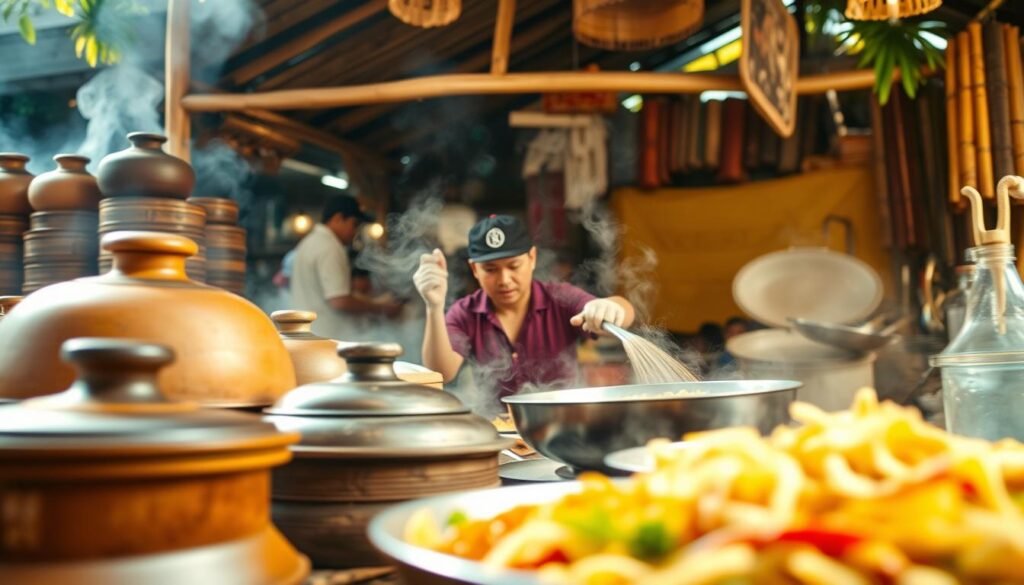
Sauces play a pivotal role in adding depth and complexity to dishes. From the tangy sinigang broth to the rich flavors of kare-kare, sauces are integral to the region’s culinary identity. They not only enhance taste but also reflect the cultural influences that have shaped these recipes over time.
The order and presentation of meals have also transformed with globalization. Traditional family-style dining has been complemented by modern plating techniques, influenced by international trends. This shift emphasizes the balance between preserving heritage and embracing innovation.
“Cooking is an art that evolves with time, yet its roots remain deeply connected to tradition.”
Today, the culinary landscape continues to evolve, with chefs experimenting with new techniques while honoring traditional methods. This dynamic interplay ensures that the essence of the past remains alive, even as the future of cooking unfolds.
Regional and Ethnic Variations Across the Archipelago
Across the Philippines, the diversity of flavors reflects the unique cultural and geographical tapestry of the islands. From the hearty dishes of the North to the spicy creations of the South, each region offers its own culinary identity. These variations are shaped by local ingredients, historical influences, and time-honored traditions.
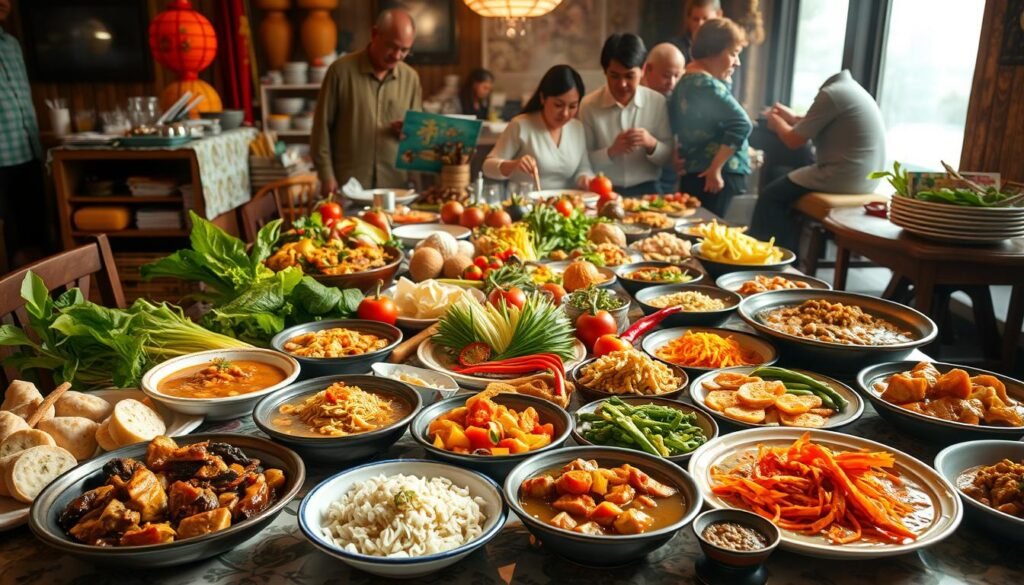
Northern, Central, and Southern Specialty Differences
In the North, dishes like bagnet (crispy pork belly) showcase the region’s love for rich, savory flavors. Central areas are known for their use of fresh vegetables, as seen in dishes like pakbet, a medley of locally grown produce. The South, particularly the Bicol region, is famous for its spicy dishes, such as laing, made with taro leaves and coconut milk.
Local restaurants often reinterpret these regional specialties, adding modern twists while preserving their essence. For example, in Cebu, lechon is served without sauce, allowing the natural flavors to shine. This adaptability highlights the creativity of local chefs.
Unique Ethnic Contributions
Ethnic groups across the archipelago have also enriched the culinary landscape. The Ilocanos, for instance, are known for their resourcefulness, using every part of the vegetable in dishes like pinakbet. In the Visayas, the use of vinegar and spices in dishes like inasal reflects a blend of indigenous and foreign influences.
These contributions are celebrated in local restaurants, where traditional recipes are given a contemporary touch. From family-run eateries to upscale dining establishments, the essence of these dishes remains intact, connecting diners to their heritage.
“Food is a bridge between the past and the present, preserving the stories of our ancestors.”
By exploring these regional and ethnic variations, we gain a deeper appreciation for the rich culinary heritage of the Philippines. Each dish tells a story of adaptation, resilience, and cultural pride. To learn more about the broader influences on these traditions, visit this detailed analysis.
American Colonial Influence: Fast Food and Modern Twists
The American colonial period brought a wave of modernization to the Philippines, reshaping its culinary landscape. This era introduced new eating habits, convenience foods, and a fast-paced lifestyle that continues to influence the country today. From fast food chains to coffee culture, the impact of American colonization is evident in daily meal patterns.
Introduction of Convenience Foods
American influence introduced convenience foods that transformed how people prepared and consumed meals. Fast food chains like KFC and McDonald’s became staples in urban areas, offering quick and affordable options. These chains not only changed eating habits but also introduced new flavors and cooking techniques.
Local restaurants began adapting these Western styles, blending them with traditional recipes. For example, the classic burger was reimagined with local ingredients, creating a unique fusion. This adaptability showcases the creativity of Filipino chefs in merging global trends with local tastes.
New Beverage Cultures and Breakfast Traditions
The American era also brought a new beverage culture, with coffee becoming a popular drink. Coffee shops emerged, offering a space for social gatherings and work meetings. This shift reflected the growing influence of Western lifestyles on local traditions.
Breakfast options expanded to include American-style pancakes, eggs, and bacon, which began appearing alongside traditional dishes. This blend of cuisines highlights the evolving nature of Filipino food culture, where old and new coexist harmoniously.
“The fusion of American and Filipino flavors has created a culinary identity that is both familiar and innovative.”
Modern Twists in Contemporary Dining
Today, the influence of American colonization is still visible in the dining habits of the Philippines. Fast food remains a popular choice, while local restaurants continue to experiment with Western-inspired dishes. The rise of food delivery apps has further increased the convenience of modern meals.
This ongoing evolution reflects the adaptability of Filipino food culture. By embracing global trends while preserving traditional flavors, the country has created a dynamic culinary scene that continues to thrive. To learn more about the broader impact of Western influences, visit this detailed analysis.
The Staple of Rice: Culture and Tradition
Rice is more than just a grain—it’s a symbol of life and unity in the Philippines. From breakfast to dinner, it is the foundation of every meal, connecting families and communities. Its cultural significance goes beyond nutrition, representing prosperity, resilience, and identity.
Rice as a Culinary and Cultural Icon
Rice is often served with a variety of dishes, from savory stews to grilled meats. It complements flavors and provides sustenance, making it a staple in every household. Whether paired with adobo or sinigang, rice transforms a simple meal into a hearty feast.
Preparation methods vary across regions, reflecting local traditions. In the North, rice is steamed to perfection, while in the South, it is sometimes cooked with coconut milk for added richness. These regional differences highlight the adaptability of rice in Filipino cooking.
Rice also plays a central role in traditional ceremonies. During weddings, grains of rice are showered on newlyweds to symbolize abundance and fertility. Before moving into a new home, rice is used in rituals to ward off evil spirits. These practices underscore its deep cultural roots.
“Rice is not just food; it’s a way of life that binds us together.”
In everyday dining, rice is a constant presence. It is the centerpiece of breakfast, lunch, and dinner, often accompanied by eggs, vegetables, or fish. Its versatility ensures it remains a beloved part of the Filipino diet.
Despite challenges in production, rice continues to be an enduring icon of Filipino tradition. Its cultural and culinary significance remains unmatched, making it a timeless symbol of unity and heritage. To learn more about the history of rice in the Philippines, visit this detailed analysis.
Festivals and Family: The Role of Food in Celebrations
From grand fiestas to intimate family gatherings, food plays a central role in Filipino celebrations. It’s more than just sustenance—it’s a way to connect, celebrate, and honor traditions. Whether it’s a national holiday or a simple reunion, the form and presentation of dishes reflect the cultural significance of these occasions.
During fiestas, the table is often filled with elaborate spreads that showcase regional specialties. Dishes like kare-kare, a rich peanut-based stew, and halo-halo, a colorful dessert, have become synonymous with festive occasions. These dishes are not only delicious but also visually stunning, with vibrant colors and intricate forms that captivate the senses.
The communal aspect of sharing meals is a cornerstone of these celebrations. Families and friends gather around the table, passing plates and sharing stories. This sense of togetherness is what makes these moments truly special. As one saying goes,
“Food tastes better when shared with loved ones.”
From Fiestas to Everyday Gatherings
Festive dishes like kare-kare and halo-halo are not reserved for special occasions alone. They often make appearances during everyday gatherings, bridging the gap between tradition and modern life. The preparation of these dishes remains rooted in time-honored methods, ensuring their authenticity while allowing for creative adaptations.
Color and presentation are key elements in festive culinary displays. Brightly colored dishes, often garnished with fresh herbs and vegetables, create a feast for the eyes. The form of the meal—whether served family-style or individually plated—enhances the dining experience, making it both memorable and meaningful.
These traditions have evolved over time, blending historic authenticity with modern appeal. For example, halo-halo now comes in various interpretations, from classic versions to innovative twists. This adaptability ensures that the essence of these dishes remains intact while appealing to contemporary tastes.
To learn more about the role of food in Filipino celebrations, visit this detailed analysis.
Street Food and the Everyday Filipino Meal
The streets of the Philippines come alive with the aroma of sizzling skewers and freshly fried snacks. From bustling markets to quiet neighborhood corners, street food vendors offer quick, flavorful meals that are a staple of daily life. These casual delicacies showcase the creativity and resourcefulness of local cooking, blending traditional methods with modern convenience.
Merienda and Other Casual Delicacies
Merienda, the Filipino tradition of afternoon snacks, is a perfect example of the street food culture. Popular items like fish balls, kwek-kwek, and banana cue are not only affordable but also deeply satisfying. These snacks often feature soy sauce or vinegar-based dips, adding a tangy kick to every bite.
Traditional cooking methods are evident in dishes like isaw, grilled chicken intestines that are marinated and skewered. The use of soy sauce and other condiments enhances the flavor, making these simple ingredients shine. Street food is more than just a meal—it’s an experience that brings people together.
Beverages like beer often accompany these casual meals, creating a relaxed and social atmosphere. Whether enjoyed at a roadside stall or a local park, street food fosters a sense of community and connection.
“Street food is the heart of everyday life, offering a taste of tradition in every bite.”
These easily accessible foods play a vital role in the daily lives of many residents. They provide a quick and affordable way to enjoy delicious meals while celebrating the rich culinary heritage of the region. From the first bite to the last, street food is a celebration of flavor, culture, and togetherness.
Kamayan: The Cultural Art of Eating with Hands
The art of eating with hands, known as kamayan, is a cherished tradition that connects people to their roots. This practice, deeply rooted in pre-colonial times, is more than just a way to enjoy a meal—it’s a celebration of community and heritage. From rural villages to urban gatherings, kamayan continues to bring people together in a shared experience of food and culture.
Origins and Etiquette of Kamayan
Kamayan traces its origins to ancient times when utensils were scarce, and hands were the primary tools for eating. This practice was documented by explorers like Antonio Pigafetta, who noted its prevalence in the 16th century. Today, it remains a symbol of simplicity and connection to the past.
In a kamayan feast, food is often served on banana leaves, creating a vibrant and communal spread. Dishes like grilled meats, seafood, and lumpia rolls are specially prepared to be enjoyed with hands. The tactile experience of picking up a roll or scooping rice adds a sensory dimension to the meal.
Etiquette plays a key role in kamayan. The technique of “pick, pack, push” ensures that food is handled gracefully. One hand is designated for eating, while the other remains clean. This practice emphasizes respect for the meal and the company shared.
Communal Bonds and Cultural Heritage
Kamayan is more than just a meal—it’s a way to strengthen bonds. Families and friends gather around the spread, sharing stories and laughter. This communal style of dining fosters a sense of belonging and unity.
Traditional condiments like soy sauce, vinegar, and calamansi enhance the flavors of the meal. These dipping sauces, known as sawsawan, allow diners to customize their experience. The use of soy and other condiments reflects the adaptability of this tradition.
“Kamayan is a reminder of our shared humanity—a way to connect with each other and our heritage.”
From Rural Roots to Urban Indulgence
While kamayan originated in rural settings, it has found a place in urban dining. Restaurants now offer kamayan feasts, introducing this tradition to a wider audience. These events often feature a mix of traditional and modern dishes, showcasing the evolution of the practice.
In cities like Manila and New York, kamayan nights have become a popular way to celebrate culture. Diners enjoy the freedom of eating with their hands, breaking away from formal dining norms. This shift highlights the enduring appeal of kamayan in a fast-paced world.
To learn more about the resurgence of kamayan and its cultural significance, visit this detailed analysis.
Modern Culinary Innovations and Global Influence
In recent years, the culinary scene in the Philippines has undergone a remarkable transformation. Modern chefs are reinterpreting traditional recipes with innovative techniques, blending heritage flavors with contemporary presentation. This evolution has not only elevated local dining but also placed the Philippines on the global culinary map.
Fine Dining Meets Traditional Flavors
Fine dining establishments are at the forefront of this culinary renaissance. Chefs are crafting dishes that honor traditional ingredients while embracing modern methods. For example, classic adobo is being reimagined with sous-vide techniques, resulting in tender, flavorful meat that retains its cultural essence.
These creative adaptations are not just about taste but also presentation. Dishes are plated with artistic precision, turning meals into visual masterpieces. This approach has attracted food enthusiasts from around the world, eager to experience the unique blend of old and new.
Culinary Tourism and International Recognition
The rise of culinary tourism has further propelled the Philippines into the international spotlight. Travelers are flocking to the archipelago to savor its diverse flavors and explore its rich food heritage. From bustling markets to upscale restaurants, every corner offers a taste of innovation.
Individual culinary personalities have played a pivotal role in this global recognition. Chefs like Margarita Forés and Jordy Navarra have championed local ingredients, showcasing their versatility on international stages. Their efforts have not only elevated Filipino cuisine but also inspired a new generation of chefs.
“Food is a universal language, and Filipino cuisine speaks volumes about our culture and creativity.”
To learn more about the journey of Filipino cuisine, visit this detailed exploration.
Conclusion
The journey of the Philippines’ culinary traditions is a testament to its rich history and cultural resilience. From its indigenous roots to its modern form, the evolution of food reflects centuries of adaptation and innovation. Staples like meat continue to play a central role, symbolizing both sustenance and celebration.
Colonial influences, particularly from Spain and America, have left an indelible mark. Regional contributions, especially from Manila, have further enriched the culinary landscape. These diverse elements have blended seamlessly, creating a unique and dynamic food culture.
Amid globalization, these traditions have not only endured but thrived. They serve as a bridge between the past and the present, connecting generations through shared meals and cherished recipes. The enduring cultural significance of these culinary practices highlights their importance in daily life and festive occasions alike.
As we reflect on this journey, it’s clear that the Philippines’ food traditions are more than just nourishment—they are a celebration of identity, heritage, and community. This dynamic evolution continues to inspire appreciation for the rich tapestry of flavors that define the nation.
FAQ
How did Spanish colonization shape the flavors of Filipino dishes?
Spanish colonization introduced new spices, cooking methods, and ingredients like tomatoes and garlic, which transformed traditional recipes into the rich, savory dishes we know today.
What role did the Manila Galleon Trade play in Filipino food history?
The Manila Galleon Trade brought ingredients like soy sauce, noodles, and spices from China and Mexico, enriching the culinary landscape with diverse flavors and techniques.
What makes adobo a quintessential Filipino dish?
Adobo is a stew made with meat, vinegar, soy sauce, and garlic. Its simplicity, versatility, and bold flavors make it a beloved staple in Filipino households.
Why is lechon often served during celebrations?
Lechon, a whole roasted pig, symbolizes abundance and festivity. Its crispy skin and tender meat make it a centerpiece for special occasions like fiestas and family gatherings.
How does rice play a central role in Filipino culture?
Rice is more than a staple food; it’s a cultural icon. It’s served in almost every meal, from breakfast to dinner, and symbolizes nourishment and unity in Filipino traditions.
What are some popular Filipino street foods?
Popular street foods include balut (fertilized duck egg), kwek-kwek (fried quail eggs), and fish balls. These affordable and flavorful snacks are enjoyed during merienda or casual outings.
What is kamayan, and how is it practiced?
Kamayan is the traditional way of eating with hands, often using banana leaves as a plate. It emphasizes communal dining and a connection to cultural roots.
How has modern Filipino cuisine evolved globally?
Modern Filipino cuisine blends traditional flavors with fine dining techniques, gaining international recognition. Chefs like Margarita Forés and restaurants like Toyo Eatery showcase this culinary innovation.
What are some regional variations in Filipino dishes?
Regional specialties include Bicol Express (spicy coconut stew) from the south, pancit Malabon (noodle dish) from the north, and kinilaw (ceviche) from coastal areas, reflecting the archipelago’s diverse flavors.
How do Filipino festivals highlight the country’s culinary heritage?
Festivals like Pahiyas and Sinulog feature elaborate food displays, traditional dishes, and communal feasts, celebrating the role of food in Filipino culture and history.
Source Links
- The Spanish Influence on Filipino Cuisine
- Spanish influence on Filipino culture
- How Spanish Cuisine Shaped Filipino Food: A Culinary Exploration – Islands Philippines
- 13 Filipino Dishes With Hispanic Influence – Tasting Table
- The Heart of Filipino Food Culture Revealed
- Filipino Cuisine: A Rich Tapestry Of Culinary Traditions
- Filipino food: a cuisine of many influences
- From Vinegar to Paksiw: A Look at Pre-colonial Philippine Food Preservation
- Cultural achievements of pre-colonial Philippines
- How Traders, Travelers and Colonization Shaped Filipino Cuisine
- A Flavorful Journey: The Impact of Spanish Colonial Rule on Filipino Cuisine
- The Impact of Spanish Colonization on Filipino Culture – Pinas Culture
- Filipino-Mexican Culinary and Cultural Exchange
- Filipino Chinese cuisine
- The Chinese Cultural Influence on Filipino Cuisine
- Filipino Food 101: Recipes to Get You Started
- The Original Fusion Food: Filipino Food Culture
- Detailed Guide to Local Cuisine of the Philippines: Traditional Filipino Food & Delicacies | Guide to the Philippines
- 50 dishes that define the Philippines | CNN
- Filipino Cooking As A Reflection of Filipino History
- Spanish Influence on Filipino Food: Beyond Adobo – pinascuisine.com
- Filipino Food Guide: Top 10 Dishes to Try in the Philippines
- Exploring Philippine Cuisine: Must-Try Dishes in Different Regions
- How Filipino food is finally finding its feet in the west
- Exploring American Culinary Impact in the Philippines – pinascuisine.com
- Jollibee: A Taste of Home for Filipinos – The World from PRX
- ‘Too Ethnic’? Here’s Why Rice is Life for Filipinos
- The Cultural Significance of Rice in the Philippines: My Journey to Understanding Rice | International & Executive Programs
- Filipino Dining and Celebrations
- Festivals & Food: 48 Hours of Fun in Manila, Philippines » Agoda: See The World For Less
- Street food in the Philippines
- Filipino Street Food: Must-Try Delicacies And Where To Find Them
- 29 Filipino Foods to Try in 2025
- Eat with Your Hands: Filipino Kamayan Dining from the San Fernando Valley to the Mission
- Make Your Next Dinner Party a Kamayan
- With A Show Of Hands, Filipino-American Chefs Rekindle Kamayan Feasts
- Filipino Food: Exploring the Rich Tapestry
- The Story of Filipino Cuisine: A Culinary Journey Through History
- Bennett: Modern Filipino food shaped by variety of cultures
- Filipino cuisine: Food that deserves to be known and eaten
- Food Culture of the Philippines: Exploring Filipino Cuisine | Discover by Silversea
- The Culinary Kaleidoscope: Unraveling Filipino Cuisine Free Essay Example

